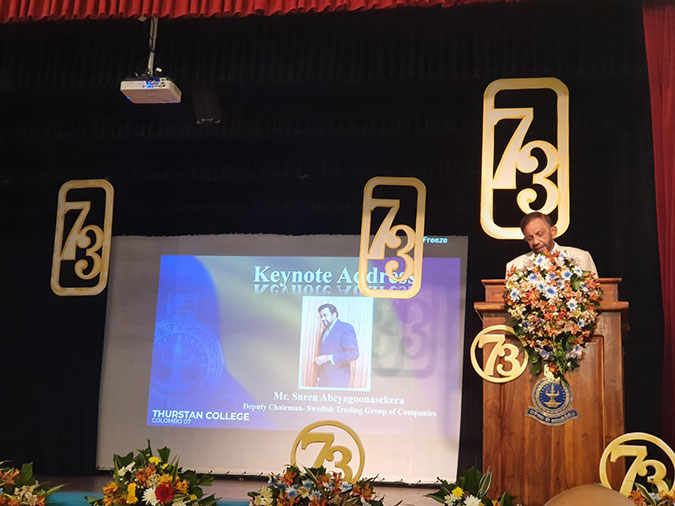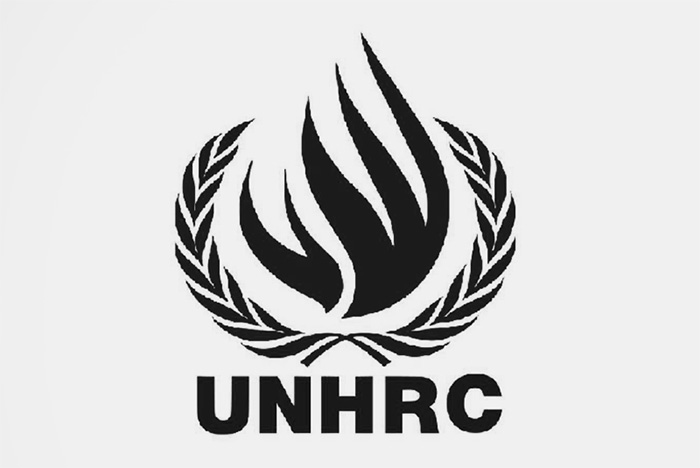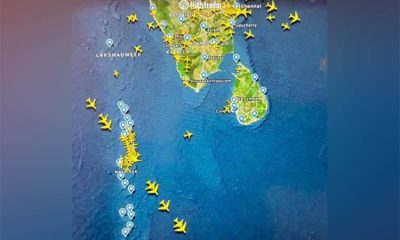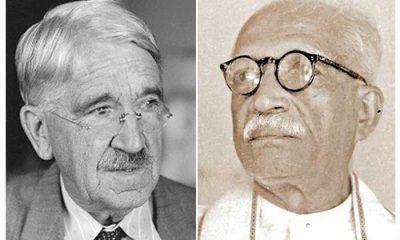Opinion
Quest for leadership

Excerpts of Suren Abeyagoonasekera’s recent Keynote address on Thurstan College on the Founder’s Day.
This is the second occasion, when I am invited to perform this traditional duty. First was during 2006~2008 period. Now, I am here again 17 Years later, before a new and a younger audience. I see and feel, several changes, developments and progress all around.
I carry memories, sweet memories, in this sacred place. There are thousands of times, that I was immersed, in my memories, of Thurstan, the remarkable people I met here, and all about THURSTAN. Stern & Soft Principals, Learned & practical Teachers, Rough and Refined friends …. so many. Although my Heart is steaming to share those remarkable events, how can I do that in 10 minutes?
Founder is a ‘a person who establishes an institution or settlement’, he is also identified as, originator, creator, initiator, and or institutor….
In that sense, we must remember,Rev A. J. Thurstan, an Anglican Missionary and priest, who founded a private technical-school that taught ‘Agricultural & Craft skills,’ in these premises , in 1859, i.e.163 years ago.
E. A. Nugawela, (then Minister of Education) who opened the Government Senior School, on 11th January 1950, a new school called the Government Senior School.T. D. Jayasuriya, Deputy Minister of education, attended the ceremony of renaming, the ‘Government Senior School’ as ‘Thurstan College’ after the founder of the first school – Rev A. J. Thurstan on 26th March 1953.
The first principal of the new school was, D. E. A. Schokman, who had previously taught, at Kingswood and Trinity Colleges. Kandy.I joined school during the tenure of Mr M D Gunawerdena as Pricipal, a strict Disciplinarian. When he leaves his office room, on his rounds, there was pindrop silence in the entire school. A very pleasant and a soft spoken person. But an Iron Fist in a velvet Glove.
He was followed by P M Jayatillake, a Gentle Giant, 6-footer, Sportsman, who held a record of 111 not out in the annual Ananda ~ Nalanda Big Match, representing Nalanda. When his record was broken by Bandula Warnapura many years later, he walked straight up to the Batsman and Congratulated. Highly knowledgeable in Dhamma, friendly with Students but firm. He engaged Grade 11,12 & 13 students often on lenthy discussions of important subjects, and invites us to write on matters of interest and submit to him, if he finds substance interesting, he will discuss it with the students. We loved this interaction. He was the founder of the Big Match, First College Magazine,and more. I was a Prefect and later his Head Prefect.
I am very happy to learn, the present Principal Pramuditha Wickramasinghe, is endowed with strong Leadership Qualities. We are very happy that the school is in safe hands. We will fully support you Sir.My subject today and always, is ‘Leadership’.
The Founders list continues, with many Principals, Teachers, Old Boys, Parents and well-wishers, who supported Thurstan to, what it is today. They committed themselves to find Teachers, funds, materials and even systems to the betterment of the Institution. They are ‘fountains of inspiration & towers of Strength’, who added value, nurtured, stood by, and enriched our Institution Thurstan.
Respected Sirs, Ladies & Gentlemen every true Thurstanite will remember, appreciate and value, your Contribution & Commitment whole heartedly.I remember Old Boys deep attachments, on two incidents, where the Old Boys rallied round Thurstan in a flash.
First was to revoke or reverse a subtle move…, which was to make Thurstan a part of another school, in which powerful people were old Boys. Thousands of Old Boys gathered in support, to negate or nullify any such move and vowed to sacrifice their lives. We had a Meeting on this Stage, Hall was. I was a speaker.Second was when Newspapers carried banner Headlines that, ‘Thurstan was under attack’. Old boys gathered quickly, to protect the Students, like a father standing before the enemy to save the next generation. Fortunately, Police intervened and restored Law & Order.
I need not tell you about the current situation of the Country. It’s a known fact, People continue to suffer without Basics…, fragile Economy, weak Education, Essentials, Medicine, Food, Global problems, etc., I will avoid touching the cause. But overall, we are forced to admit the absence of Visionary True Leaders. We all know about it. It’s not the best.., all of you will have various ways of analysing. I wouldn’t enter a debate.
When I was newly elected to the 30 Member Executive Committee, of the Colombo YMBA – Young Mens Buddhist Association, I asked the Seniors ‘what do you think…, is the problem of this country..’ there were several responses, Terrorism, weak Leaders, dirty politics, Bribery, Corruption, indiscipline, etc.,’
My answer was, all of them are due to, none, but ‘Lack of Quality Leaders’. We have lost many potential Leaders who aspired for a Change.They were misled, we lost them first in 1971, then in 1988, finally young and valiant men who joined the army to save the country.
Sadly, successive leaderships, failed to groom the next line of Leaderships, which is the Prime Responsibility of any Leader. We have to build future Leaders, to take this Country forward. Future Leaders must possess true Leadership Qualities. We are 30 Years behind the rest of the world, we have lost a great deal of valuable time, and we have to catch lost time.
I swear, IQ level of our Youth, is greater than, many of our neighbours. But we have failed to give them correct inputs, and best practices & guidance. If children are given bad inputs, the results are weak.
I proposed to YMBA and launched ‘Young Buddhist Leadership Training Programme’. Course content, will begin with Exercise and Meditation. Then to Managala Sutta, Parabhava Sutta, Singalovada Sutta, finally to ‘Leadership Qualities of Gauthama Buddha. The proposal was enriched by famous Civil Servant, Olcott Gunasekera,(now Ven Vajiraramaye Gnanaseeha) and Luxman Hettiaarachchi (former Chairman of Walkers). It was Launched, we trained the first batch of 20 at Maharagama Dharmayathanaya, and went upto 200. It was a week long course. Now we take the module Islanwide, on a One Day Course.
Dear Students, trust me, believe me, the soil of Thurstan is magical. I still can’t fathom. Either the earth you trample at Thurstan is sacred, or our Historic Nuga Tree gives you the vibes of ‘fearless Leadership. Look back the Leaderships we have gained, in 74 Years, and as a ratio, in comparison to older schools with 6000, or 8000 student population. We are small. Never make the mistake of going into big numbers. I believe Education is not for mass production that ignores quality.
I spoke to some of your teachers, believe me they are a class. They are very resourceful, they are confident, and have faith in Principals Leadership.
Dear Students,
Let me remind our Moto ‘Thamasoma Jya thigramaya, meaning …From Darkness to Light…thus, it’s in our DNA.
To move from ‘Darkness to Light’ we need Visionary Leadership, valour and couragesness. We do have them, isn’t it?
I wish younger generations will understand the vacuum in Leadership.
An Indian, became the Prime Minister of England, another Indian may become Head of USA. But their grooming may have begun 20 years ago.
I am telling you seriously, many people left the country in a hopeless mind. Will you believe that we can not produce strong Leaderships ?
This is a blessed Country, with many rare resources, a highly fertile Land with five Rivers, staring from the Central Hills in five Directions enriching soil we were born and fed. You have blessed Teachers, and your feet firmly on the ground of Thurstan.
Dear Students, you are gifted with a Leader, with far reaching Vision & Wisdom, A good Panel Teachers, and dedicated Old Boys and well-wishers.
Dear Principal, I respectfully propose, Thurstan to produce, unwavering lines of ‘Excellent Leaders’
I will conclude with a line, my respected Principal P M Jayatillake taught us…..,
The heights by great men reached and kept, were not attained by sudden flight, but they, while their companions slept, were toiling upward in the night – Henry Wadsworth Longfellow
Opinion
Towards a more profitable and sustainable agriculture

BY Upatissa Pethiyagoda
One of the key happenings in human history, is the so-called “Industrial Revolution,” that originated about two centuries ago, with Europe, North America and Japan, as the focal points. These are now broadly defined as “Developed Countries.” They distinguish themselves as having higher per capita incomes, and thereby offering their citizens better living conditions than do the ‘developing’ or ‘less developed’ ones.
It is tempting yet erroneous, to believe that what prevailed two centuries ago, can be transposed today to other countries including Sri Lanka, presently classified among the “Developing countries.”
Typically, the industrial era manifested as a movement away from labour and towards machinery driven enterprises. The unspoken assumption is that what worked for them then, should do for us now.
This is a presumption that is unlikely to happen. Although a small Tropical country within the Monsoon belt, we are fortunate in being generally spared weather-related atmospheric perturbations such as hurricanes, cyclones and tsunamis, which assail other similar sized countries and locations.
Overall, we are also fortunately blessed with largely favourable climatic conditions and reasonably fertile soils, to ably support a sustainable, diversified and a seemingly unique mosaic of farming, livestock and forestry. This is worthy of protection.
By virtue of our geography, climate, tradition and aptitude, we are well positioned to be a dominant base for a vibrant Agrarian Economy. A composite of the sectors associated with plants and animals, best suits our natural strengths. This leads us logically to seek economic advancement through this sector, with a blend of farming, livestock and forestry, to best support environmental stability as our long-term goal.
Two factors that are poised to impact on Worldwide agriculture, are “global warming” and a looming “water crisis.” These will affect different regions with differing severity. These possible hazards have aroused much International concern. Sri Lanka would do well to prepare itself for these eventualities.
In the particular context of Sri Lanka, the major concerns would lie in the agrarian, forestry, fishery and environmental sectors. The focus for close and timely attention include the following:
(i) Correcting weaknesses in the Extension Services which are primarily blamed for under- performance. All officers concerned in the above sectors, would benefit from periodic exposure to training that is designed for upgrading knowledge and sharpening requisite skills.
(ii) The Sri Lankan Agricultural Sector divides itself into two components, namely, the Export and Local Crop sectors. Animal farming is set apart, and historically has received less attention. However, the recently expanding poultry industry has resulted in greater attention to livestock expansion.
(iii) In Ceylon’s colonial history, it was the British who eventually exercised their sovereignty over the whole country, succeeding the Portuguese and Dutch, who were confined to the coastal regions. Cinnamon was the first crop that attracted the colonisers, followed sequentially by Cinchona (Pyrethrum, on a small scale) and Coffee. In the 1840s, the invasion by the Coffee Rust (Hemileia vastatrix), laid waste to the Coffee plantations. Tea took over and rapidly expanded, mainly by encroaching into Highland Forest areas. Little attention was given to environmental and social consequences. Meanwhile, rubber plantations dominated in the wetter Lowlands. A while later, attention was directed towards Coconut.
(iv) Research Institutes – TRI, RRI and CRI were established to cater to the needs of the fast developing Plantation Crops.
The introduction of Plantation Crops had far-reaching and lasting Economic, Political, Social, Environmental and Cultural consequences. The more recently established Minor Export Crops, (renamed as The Export Crops Sector) mainly services the Spice Crops – Cinnamon, Pepper, Nutmeg and Cardamom. Also Cocoa and Coffee. Sugar, Cashew and Palmyrah are crops that are developing their own support structures.
(v) All others are catered for by the Department of Agriculture, whose main efforts are understandably focused on the Paddy sector. This is a sector that had received scant attention from the colonial British, who had an understandable preference for importation of rice from their colonial Burma and Thailand.
(vi) The cleavage (into export and local sectors), while having several operational advantages, also created problems. Seriously, the result is an inequality in resources (most notably in the matter of qualified staff) and consequent waste.
A major problem in consolidation and improving the services of research and extension arises from differences in the sources of funding. The TRI is funded entirely by a cess on exports, while the Departments of Agriculture and Minor Export Crops are dependent entirely on the government, and the RRI and the CRI by a mix. This has resulted in big differences in staff strengths and organisational complications. There are thus an under-utilisation of staff, facilities and distorted priorities.
(vii) The tea industry in its early expansive phase, relied heavily on indentured labour from South India. This coupled with the unjust expropriation of lands belonging to locals, particularly those of the Kandyan peasantry, and the ecological damage by unrestricted invasion into forest areas in the central hills, has created seething resentment and ecological harm. The massive importation of South Indian labour, particularly in the expansion phase of the tea industry, have resulted in social, economic and political complexities prevailing even now. This is still a silent concern.
(viii) Since it is impossible to balance the requirements and production of agricultural produce, scarcities and gluts are not uncommon. Scarcities are met by imports, while surpluses largely result in waste. This can be as high as 35% in the case of perishable vegetables and fruits.
This is a colossal loss. It is scarcely possible to point to a single agronomic practice that can provide a similar return. Thus, if such losses can be limited or eliminated, the impact will be considerably greater than any improvement in agronomic practice. This must be a binding pre-requisite for a sustainable agriculture. Quality improvement begins with timely harvesting, minimising bruising, exposure to light and heat, packaging and transport. Models are available for delicate or vulnerable products (e. g. Bananas and Cut Flowers) that could offer hints of what procedures and facilities such as “Cold Chains” are necessary or feasible.
(ix) To deal with product surpluses, obvious remedies include providing better storage facilities with protection from insects, fungi, rodents and other marauders. Such storage could suit Paddy, maize, pulses, peanuts and some fruits. In the case of vegetables, many fruits and other perishable produce, post-harvest handling and transport are key needs. Where appropriate, preservation by simply drying (by Sun, ovens or other equipment), freezing, canning, bottling and packaging are means of coping with surpluses and in most cases, also as a means of value addition.
These are the considerations paramount in developing a profitable and sustainable Agriculture – which will continue to play a key role in the National Economy. The focus should change to an Agriculture prioritizing Food Security, import substitution and improvements of farmer livelihoods.
(x) Land Use. Hitherto, the agricultural services have been “crop based”, largely for historical reasons. By far, a change to an emphasis on a “Land use” paradigm, would be logically, economically and environmentally more sound. Despite the inconvenient financing and logistics issues, on balance, the benefits in the long term will decidedly outweigh the initial effort.
(xi) Agricultural Shows offer great opportunities to track and procure genetically superior cultivars for multiplication. This will play a vital role. Technologies evolved in Home Garden and Plant House efforts are obvious sources of new knowledge and practices.
(xii) A persistent problem in Colonization Schemes is to retain, support sustainable cropping patterns, capable of sustainable livelihoods. The common tool is to provide Model Units to combine crop, livestock, pastures, and Forestry, with choices and production designs and “mock-ups” for different sizes of land allocations.
(xiii) “Going organic” is certainly much superior in maintaining soil fertility, reducing erosion, and supporting more favorable conditions for maintaining the soil biome (bacteria and earthworms), mitigating ill effects of continuous reliance on chemicals for nutrient needs, weed-killers and pesticides. A soil devoid of its natural diversity is effectively dead and in its sterility becomes a mere unsustainable anchoring medium.
(xiv) In our particular case, there is an alarming decline in fertility and increase in soil erosion, resulting from heavy and long term application of artificial fertilizers (especially ammonium sulphate for tea). A total and objective and unbiased intervention, to examine the costs (including maintenance and “opportunity cost”) and returns. This may result in surprising revelations but need not deter a re-evaluation.
Opinion
UNHRC faux pas: BRICS yet another!

Tamara Kunanayakam deserves the gratitude of all Sri Lankans concerned by the machinations of US and its allies, for the excellent commentary titled “UNHRC resolution, good governance, BRICS – Operation camouflage?” (The Island, 11 November). She is an experienced diplomat and was the Permanent Representative of Sri Lanka to the United Nations Office at Geneva from 2011. She successfully defended Sri Lanka at UNHRC when the process of passing resolutions against Sri Lanka started.
While the odd behaviour of the government regarding BRICS, which she had gone into detail in her piece, was very much in the news, what she stated about the UNHRC resolution focuses on the intentions as well as capabilities of the JVP/NPP government. This coming from a person with intimate knowledge of the workings of the UNHRC, gives added weight.
Vijitha Herath, the government spokesman’s declaration that the UNHRC resolution drafted by USA/UK and presented to the council by the UK was ‘strongly rejected’ by the government got wide coverage in the media. However, what followed was hardly mentioned and I was surprised and taken aback by the following paragraphs in her commentary:
“Nevertheless, on that same day, the resolution that the Government had “strongly” rejected was adopted without a vote, i.e., by consensus, and consensus resolutions necessarily involve the explicit or implicit consent of the country concerned.
Had indeed the Government “rejected” the external mechanism, it would have called for a recorded vote, the only way to prevent consensus on a hostile draft. Being a non-member state, it would have had to request a friendly country to act on its behalf, and Cuba, China and Pakistan have always obliged. Without a specific request from Sri Lanka, no country that respects the principle of state sovereignty and the right of peoples to self-determination would have called for a vote. It is evident that that request never came. By the decision not to call for a vote, the Government did the opposite of what it had said it would do, even reversing Sri Lanka’s previous rejection of the mechanism at the Council’s 2021and 2022, and consenting to its establishment as well as extension.”
This action of the government raises very significant issues. Was this lapse, if indeed it was, due to inexperience? Or, has the faux pas exposed the sheer incompetence of this government? Worse still, is this government also run by a Viceroy?
Perhaps, as she alludes to, it is an ‘operation camouflage’
Dr Upul Wijayawardhana
Opinion
Valuation Department – a sick giant in deep slumber

Seventy-nine months – six years and seven months – for a file to be cleared by the slack officers in the Valuation Department. Finally, after much effort, in June 2023, a lady officer was cajoled to look into it. The file that was in hiding was retrieved from some deep dungeon and a clerk was directed to work on it. In July 2023, the completed file was sent to the Divisional Secretariat, Kotte. The formal valuation was sent to me – and I detected a serious error in the valuation as the extent of my land given in the document was totally erroneous. Surveyor General official document following surveying the land in 2017, has certified my ownership as 0.0337 HECTARES.
(1 HECTARE IS EQUAL TO 395.3686 PERCHES)
On this basis, the extent of my block of land is 13.3239 PERCHES.
This is the only block of land I own. It is situated off Temple Road in the vicinity of the Open University. I was notified that it had been earmarked for acquisition for Flood Control Project Development purposes by the SLRDC. For the valuation that has to precede the granting of compensation for my land, I had to go through formalities such as repeatedly surveying the land, obtaining legal documents to prove my ownership and several other documents and information connected with it. These procedures have cost me a large sum of money as well as time and hard work. After several months of tedious labour running from pillar to post, SLRDC was satisfied that the requirements are in order.
SLRDC SENT DOCUMENTS TO VALUATION DEPARTMENT IN 2018
Thereafter, the documents were sent from SLRDC to the Valuation Department on January 2nd 2018—more than 6 years ago. The file has been lying on the desk of an officer through all these months. When inquiries were made in 2020 from time to time the officer dealing with my file was habitually late for work, not in her seat, absent for days due to illnesses like ear ache, etc. These were the frivolous excuses given for not attending to my file. She is currently transferred to an office in Maharagama.
Three reminders were sent by SLRDC to Valuation Department to expedite the valuation. Yet, the reminders were totally ignored.
Valuation Department after a very long period of 79 months, has woken up and has sent a valuation that shows the extent as 0.0337 PERCHES with a value stated as Rs.100,000 for the entire extent of 13.3239 Perches. This valuation is totally erroneous and quite suspicious as there seems to be a sinister move to put me off the track and carry out some underhand dealing. Where would anyone get even ONE perch of valuable land in Nawala for that amount?
This is a fraudulent valuation. My file was kept in hiding for over 6.5 years from 02 January 2018 to July 2023. I have been constantly trying to make the Valuation Department work on it – writing to them numerous letters, appeals and personally trying to meet the relevant officers but to no avail. I sent a formal complaint to the Chief Valuer. Never did I receive a response. This is the extremely slack, careless and inefficient manner in which the officers of the Valuation Department discharge their duties. This Department that handles money worth millions needs to be fully overhauled and the entire officers from top to bottom need a thorough cleansing. It is a hell hole of corruption.
I am writing this with great pain of mind and utter disappointment regarding the unexplained huge delay and final careless and fraudulent valuation that is being awarded to me. I am certainly not prepared to accept this minuscule award.
I was also notified that in the event that I do not accept the decision, I could appeal to a Reviews Board. I sent my appeal promptly under registered cover to the Reviewing Board in September 2023. In my appeal I stated that nowhere in the vicinity of Nawala so close to the Open University and other strategic places could one buy even one perch of land for Rs.100,000. This undervaluation shows some hidden agenda which I am certain of. The extent shown on the official valuation is incorrect. It is NOT .0337 Perches BUT .0337 HECTARES.
There are houses alongside mine and professionals residing in the adjoining blocks; this being a highly residential area in the heart of the city. My land has some trees and vegetation. At some moment in time, former president Gotabaya Rajapaksa had in a high-handed manner and without my knowledge or approval dug a trench across my land and another block bordering mine.
Since my appeal to the Reviewing Board, one year has also gone by and the appeals officer also is in deep slumber. I called a few times to see if the matter is being attended to and was vaguely told that they have sent it to SLRDC, Kotte for some further information. When I contacted SLRDC, I was told that the information had been sent promptly. Appeals section lady officer gave vague answers when called again. She is still silent. One does not know who is lying. These are state officials entrusted with providing responsible service to people. The Valuation Department hung onto my file for over 79 months (six and a half and more years) with absolutely nothing being done and now finally a blatant error in extent of the land.
Seventy-nine months is an awful lot of time to deal with many matters that are important to my life. I am sure that these comments of mine are shared by many others whose files are stagnating at the Valuation Department due to the negligence and lackadaisical attitude of the officers from the highest to the lowest in that department.
President Anura Kumara Dissanayake has an Augean task to clean up these filthy, foul- smelling stables, shake the sleeping officers from their deep slumber and get them to work as they should. Replies to letters, correspondence from the public have to be answered promptly is another duty these officers are bound to carry out. In this era of technology, emails could do the job.
When one surfs the website, there are many officers with high-flown credentials but sadly they do not seem to have control over those who hide files for whatever undisclosed reason. Over to the Chief and others in authority at the top to solve this problem of mine as I am at the mercy of slack and careless officers at the Valuation Department. In concluding, I wish to say that valuation means numbers and the officers need to be given basic lessons in Arithmetic, land and area extent conversion tables. They cannot and must not make glaring mistakes in cases such as mine.
M. P. Warusawithana
empeew@gmail.com
-

 News6 days ago
News6 days agoHarin drags Messi into poll mess
-

 Features5 days ago
Features5 days agoAdani’s ‘Power’ in Sri Lanka
-

 Opinion7 days ago
Opinion7 days agoSri Lanka’s missed opportunities
-

 Latest News2 days ago
Latest News2 days agoColombo district preferential votes announced
-

 Editorial6 days ago
Editorial6 days ago‘Political prisoners’
-

 Features6 days ago
Features6 days agoEducation, democracy and unravelling liberal order
-

 News2 days ago
News2 days agoPresident warns his party: “We will fail if we view power as an entitlement to do as we please”
-

 Editorial7 days ago
Editorial7 days agoCorpse-driven politics











